The Cambridge History of Japan, Vol. 1: Ancient Japan
Подождите немного. Документ загружается.


GENERAL PROBLEMS 327
archaeological methods must be applied to the study of religious arti-
facts,
and folklorists' methods must be used in the examination of
ceremonies currently conducted at Shinto shrines that undoubtedly
contain elements from the past. Our ability to retrace ancient Shinto
has been enhanced considerably by the proliferation of research in the
free intellectual atmosphere that followed World War II. The efforts of
many postwar scholars have solved some of the riddles of the ancient
period.
Basic research in this area has been carried out by numerous schol-
ars.
Naoki Kojiro, Tsukushi Nobuzane, Okada Seishi, and I have
studied the origins of the worship of the Sun Goddess and of festivals
held at Ise Shrine, the most important national shrine and the one
where the Sun Goddess has been worshiped since the beginning of
my fourth period. Ueda Masaaki and Yoshii Iwao have examined
relationships between provincial clans and the ancient imperial court.
Mizuno Yu, Torigoe Kenzaburo, and I have conducted research into
the legends of Japan's Izumo region. Saigo Nobutsuna, Tanaka
Hatsuo, and I have studied court ceremonies such as the Great Feast
of Enthronement conducted at the beginning of a new reign and the
yearly winter festival, the Chinkonsai ("Soul-quieting festival"). In
the field of art history, important contributions have been made in
Shinto architecture by Fukuyama Toshio, Watanabe Yasutada, and
Inagaki Eizo. Kageyama Haruki's studies of iconography, Oba Iwao's
archaeological investigations, and Nishida Nagao's intensive examina-
tion of old shrine documents have been important.
1
' In this chapter,
19 Naoki Kojiro, Nihon kodai no shizoku to lenno (Tokyo: Hanawa shobo, 1965); Tsukushi
Nobuzane,
Amaterasu no tanjo
(Tokyo: Kadokawa shoten, 1961); Okada Seishi, Kodai
oken
no
saishi
to shinwa (Tokyo: Hanawa shobo, 1970), pp. 37-150; Matsumae Takeshi, Kodai
densho
to kyulei saishi
(Tokyo:
Hanawa shobo, 1974); Matsumae Takeshi, Nihon
no kamigami
(Tokyo:
Chuokoronsha, 1974), pp. 90-182; Ueda Masaaki, Nihon shinwa (Tokyo: Iwanami shoten,
i960);
Yoshii Iwao,
Tenno
no keifu to shinwa, 2 vols. (Tokyo: Hanawa shobo, 1967 and 1976);
Mizuno Seiichi, Izumo shinwa (Tokyo: Yagumo shobo, 1972); Torigoe Kenzaburo, Izumo
shinwa mo
seiritsu
(Tokyo: Sogensha, 1966); Matsumae Takeshi, Nihon shinwa no keisei (To-
kyo:
Hanawa shobo, 1970); Matsumae Takeshi, Izumo
shinwa
(Tokyo:
Kodansha, 1976); Mat-
sumae Takeshi, "The Origin and Growth of the Worship of Amaterasu," Asian Folklore
Studies 38 (1978): 1—11; Matsumae Takeshi, Yamato kokka to shinwa densho (Tokyo:
Yuzankaku, 1986); Saigo Nobutsuna, Kojiki kenkyu (Tokyo: Miraisha, 1975); Tanaka
Hatsuo, Senso Daijosai (Tokyo: Mokujisha, 1975); Fukuyama Toshio, Nihon kenchiku shi
kenkyu (Tokyo: Bokusui shobo, 1968); Fukuyama Toshio, Nihon
no yashiro
(Tokyo: Bijutsu
shuppansha, 1962). Also see Yasutada Watanabe, Shinto Art: Ise and Izumo Shrines, trans.
Robert Ricketts (New York and Tokyo: Weatherhill/Heibonsha, 1974); Inagaki Eizo, Kodai
nojinja
kenchiku
(Tokyo: Bijutsu shuppansha, 1973); Kageyama Haruki,
The
Arts of Shinto,
trans.
Christine Guth (Tokyo: Weatherhill, 1973); and Oba Iwao, Saishi iseki: Shinto
kokogaku no kisoteki kenkyu (Tokyo: Kadokawa shoten, 1970). For detailed studies, see Oba
Iwao,
ed., Shinto
kokogaku
ronko,
6 vols. (Tokyo: Yuzankaku, 1971); Nishida Nagao, Nishida
Nagao
zenshu,
10 vols. (Tokyo: Kodansha, 1978-79).
Cambridge Histories Online © Cambridge University Press, 2008
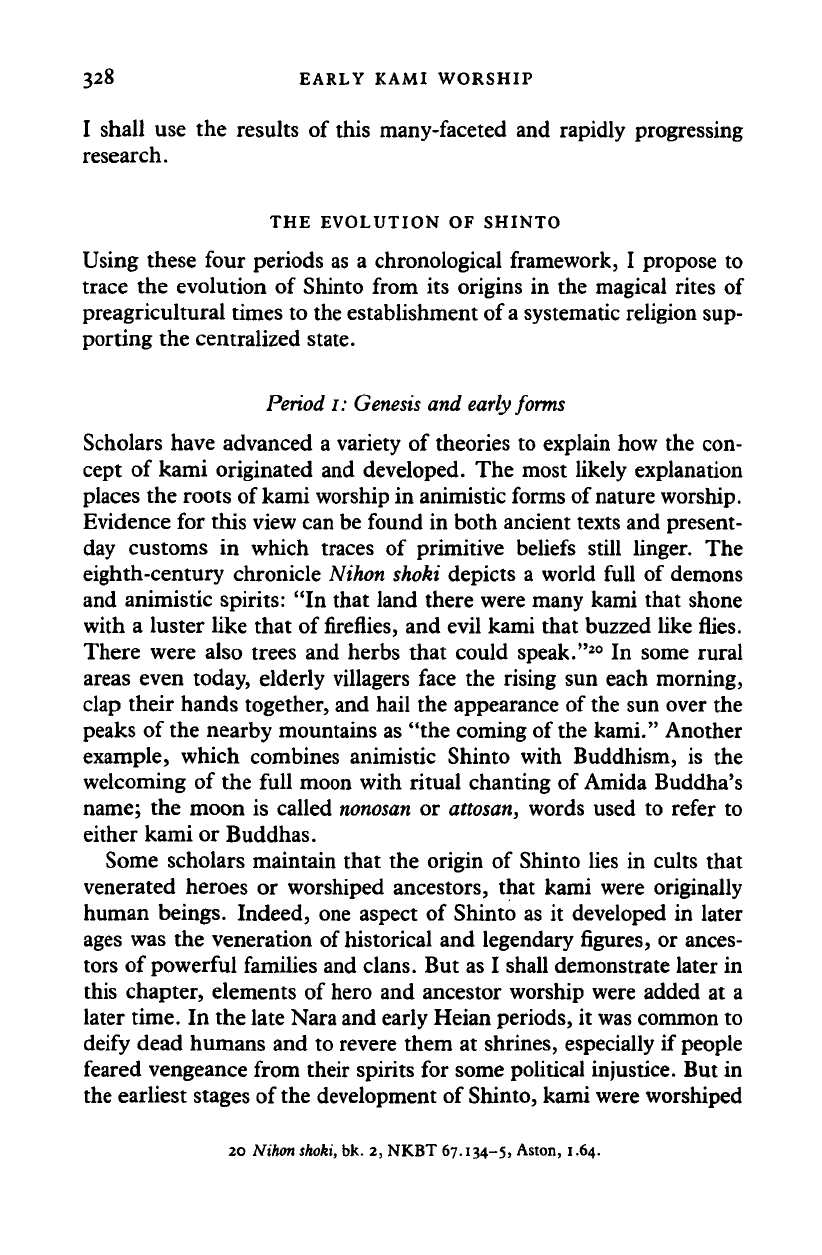
328 EARLY KAMI WORSHIP
I shall use the results of this many-faceted and rapidly progressing
research.
THE EVOLUTION OF SHINTO
Using these four periods as a chronological framework, I propose to
trace the evolution of Shinto from its origins in the magical rites of
preagricultural times to the establishment of
a
systematic religion sup-
porting the centralized state.
Period i: Genesis and
early
forms
Scholars have advanced a variety of theories to explain how the con-
cept of kami originated and developed. The most likely explanation
places the roots of kami worship in animistic forms of nature worship.
Evidence for this view can be found in both ancient texts and present-
day customs in which traces of primitive beliefs still linger. The
eighth-century chronicle Nihon shoki depicts a world full of demons
and animistic spirits: "In that land there were many kami that shone
with a luster like that of fireflies, and evil kami that buzzed like flies.
There were also trees and herbs that could speak."
20
In some rural
areas even today, elderly villagers face the rising sun each morning,
clap their hands together, and hail the appearance of the sun over the
peaks of the nearby mountains as "the coming of the kami." Another
example, which combines animistic Shinto with Buddhism, is the
welcoming of the full moon with ritual chanting of Amida Buddha's
name; the moon is called
nonosan
or
attosan,
words used to refer to
either kami or Buddhas.
Some scholars maintain that the origin of Shinto lies in cults that
venerated heroes or worshiped ancestors, that kami were originally
human beings. Indeed, one aspect of Shinto as it developed in later
ages was the veneration of historical and legendary figures, or ances-
tors of powerful families and clans. But as I shall demonstrate later in
this chapter, elements of hero and ancestor worship were added at a
later time. In the late Nara and early Heian periods, it was common to
deify dead humans and to revere them at shrines, especially if people
feared vengeance from their spirits for some political injustice. But in
the earliest stages of the development of Shinto, kami were worshiped
20 Nihon shoki, bk. 2, NKBT 67.134-5, Aston, 1.64.
Cambridge Histories Online © Cambridge University Press, 2008
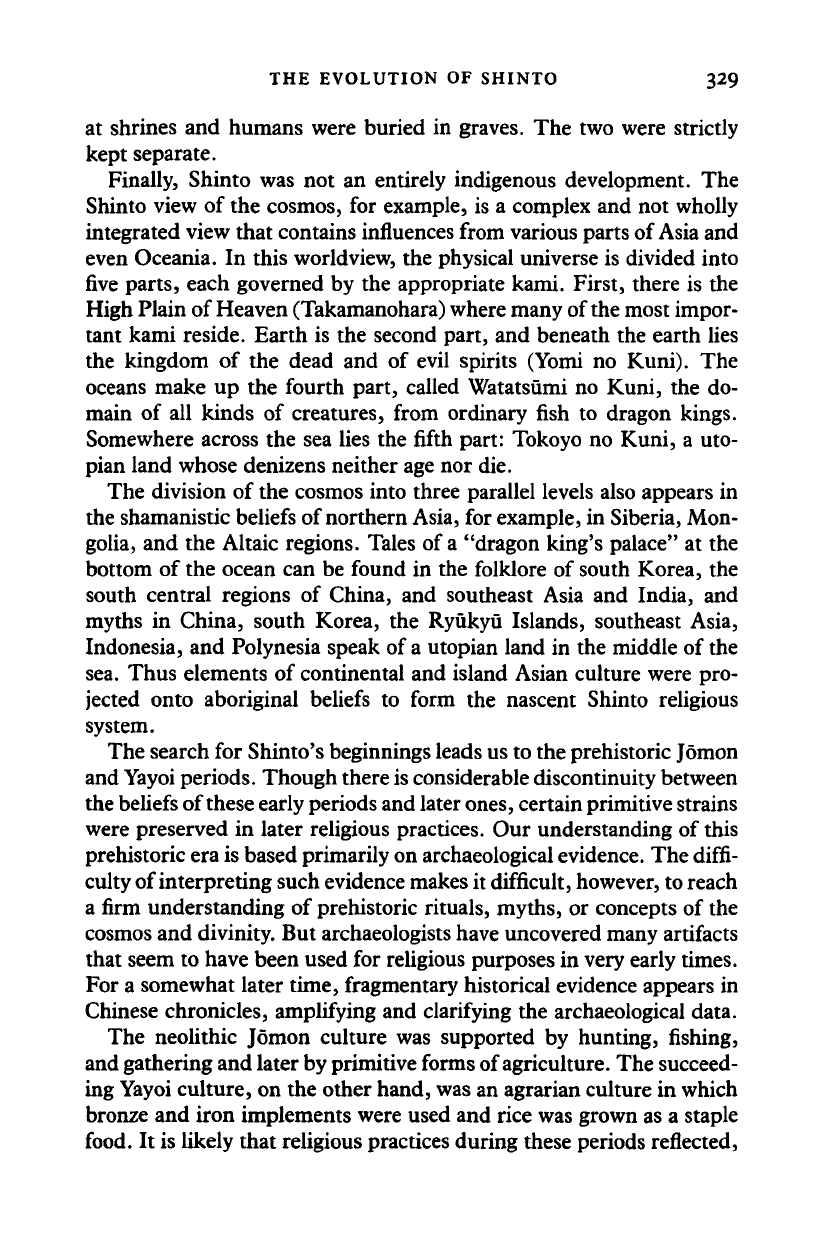
THE EVOLUTION OF SHINTO 329
at shrines and humans were buried in graves. The two were strictly
kept separate.
Finally, Shinto was not an entirely indigenous development. The
Shinto view of the cosmos, for example, is a complex and not wholly
integrated view that contains influences from various parts of Asia and
even Oceania. In this worldview, the physical universe is divided into
five
parts,
each governed by the appropriate kami. First, there is the
High Plain of Heaven (Takamanohara) where many of the most impor-
tant kami reside. Earth is the second part, and beneath the earth lies
the kingdom of the dead and of evil spirits (Yomi no Kuni). The
oceans make up the fourth part, called Watatsumi no Kuni, the do-
main of all kinds of creatures, from ordinary fish to dragon kings.
Somewhere across the sea lies the fifth part: Tokoyo no Kuni, a Uto-
pian land whose denizens neither age nor die.
The division of the cosmos into three parallel levels also appears in
the shamanistic beliefs of northern Asia, for example, in Siberia, Mon-
golia, and the Altaic regions. Tales of
a
"dragon king's palace" at the
bottom of the ocean can be found in the folklore of south Korea, the
south central regions of China, and southeast Asia and India, and
myths in China, south Korea, the Ryukyu Islands, southeast Asia,
Indonesia, and Polynesia speak of
a
Utopian land in the middle of the
sea. Thus elements of continental and island Asian culture were pro-
jected onto aboriginal beliefs to form the nascent Shinto religious
system.
The search for Shinto's beginnings leads us to the prehistoric Jomon
and
Yayoi
periods. Though there
is
considerable discontinuity between
the beliefs of these early periods and later
ones,
certain primitive strains
were preserved in later religious practices. Our understanding of this
prehistoric era is based primarily on archaeological
evidence.
The diffi-
culty of interpreting such evidence makes it difficult, however,
to
reach
a firm understanding of prehistoric rituals, myths, or concepts of the
cosmos and divinity. But archaeologists have uncovered many artifacts
that seem to have been used for religious purposes in very early times.
For a somewhat later time, fragmentary historical evidence appears in
Chinese chronicles, amplifying and clarifying the archaeological data.
The neolithic Jomon culture was supported by hunting, fishing,
and gathering and later by primitive forms of agriculture. The succeed-
ing Yayoi culture, on the other hand, was an agrarian culture in which
bronze and iron implements were used and rice was grown as a staple
food. It is likely that religious practices during these periods reflected,
Cambridge Histories Online © Cambridge University Press, 2008
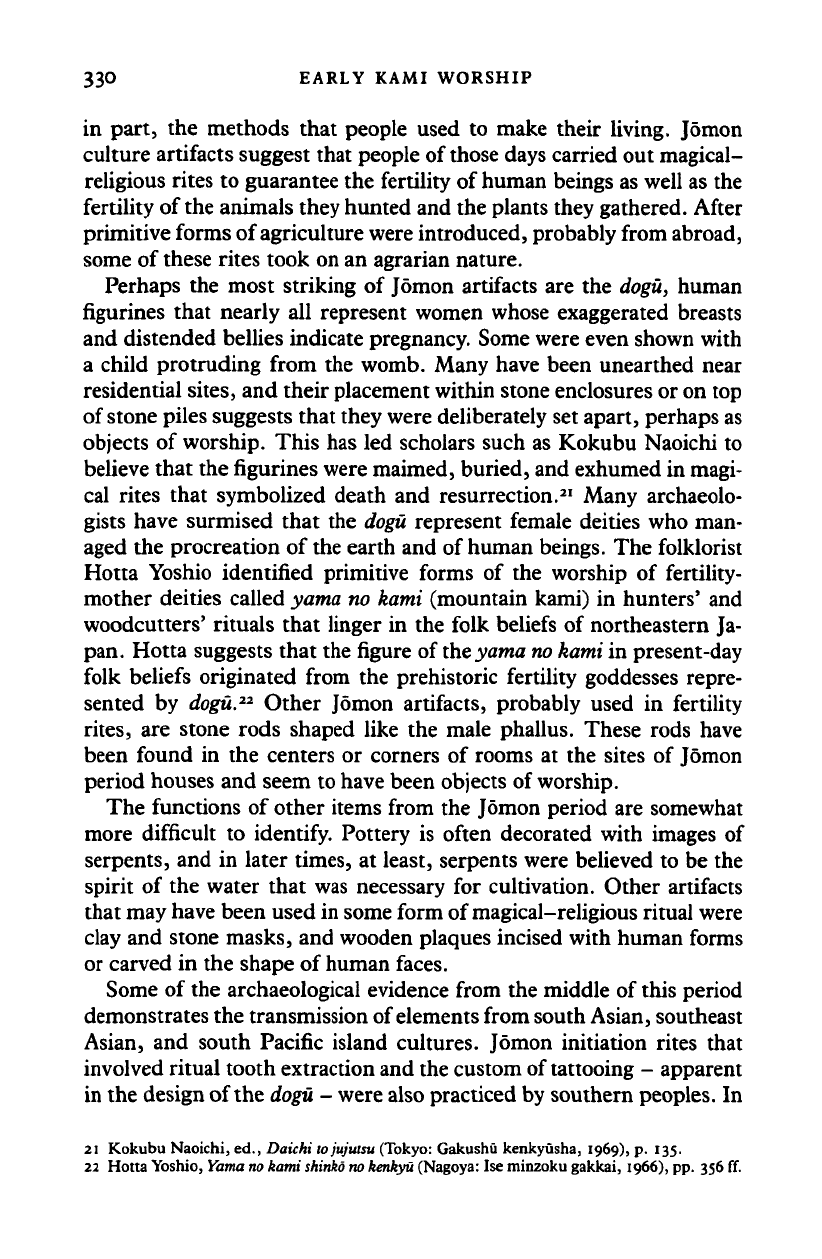
330 EARLY KAMI WORSHIP
in part, the methods that people used to make their living. Jdmon
culture artifacts suggest that people of those days carried out magical-
religious rites to guarantee the fertility of human beings as well as the
fertility of the animals they hunted and the plants they gathered. After
primitive forms of agriculture were introduced, probably from abroad,
some of these rites took on an agrarian nature.
Perhaps the most striking of Jomon artifacts are the
dogu,
human
figurines that nearly all represent women whose exaggerated breasts
and distended bellies indicate pregnancy. Some were even shown with
a child protruding from the womb. Many have been unearthed near
residential sites, and their placement within stone enclosures or on top
of stone piles suggests that they were deliberately set apart, perhaps as
objects of worship. This has led scholars such as Kokubu Naoichi to
believe that the figurines were maimed, buried, and exhumed in magi-
cal rites that symbolized death and resurrection.
21
Many archaeolo-
gists have surmised that the
dogu
represent female deities who man-
aged the procreation of the earth and of human beings. The folklorist
Hotta Yoshio identified primitive forms of the worship of fertility-
mother deities called yama no kami (mountain kami) in hunters' and
woodcutters' rituals that linger in the folk beliefs of northeastern Ja-
pan. Hotta suggests that the figure of the yama
no
kami in present-day
folk beliefs originated from the prehistoric fertility goddesses repre-
sented by dogu.
22
Other Jomon artifacts, probably used in fertility
rites,
are stone rods shaped like the male phallus. These rods have
been found in the centers or corners of rooms at the sites of Jomon
period houses and seem to have been objects of worship.
The functions of other items from the Jomon period are somewhat
more difficult to identify. Pottery is often decorated with images of
serpents, and in later times, at least, serpents were believed to be the
spirit of the water that was necessary for cultivation. Other artifacts
that may have been used in some form of magical-religious ritual were
clay and stone masks, and wooden plaques incised with human forms
or carved in the shape of human faces.
Some of the archaeological evidence from the middle of this period
demonstrates the transmission of elements from south Asian, southeast
Asian, and south Pacific island cultures. Jomon initiation rites that
involved ritual tooth extraction and the custom of tattooing - apparent
in the design of the
dogu
- were also practiced by southern peoples. In
21 Kokubu Naoichi, ed., Daichi lojujutsu (Tokyo: Gakushu kenkyusha, 1969), p. 135.
22 Hotta Yoshio, Yama
no
kami
shinko no kenkyu
(Nagoya: Ise minzoku gakkai, 1966), pp. 356 ff.
Cambridge Histories Online © Cambridge University Press, 2008
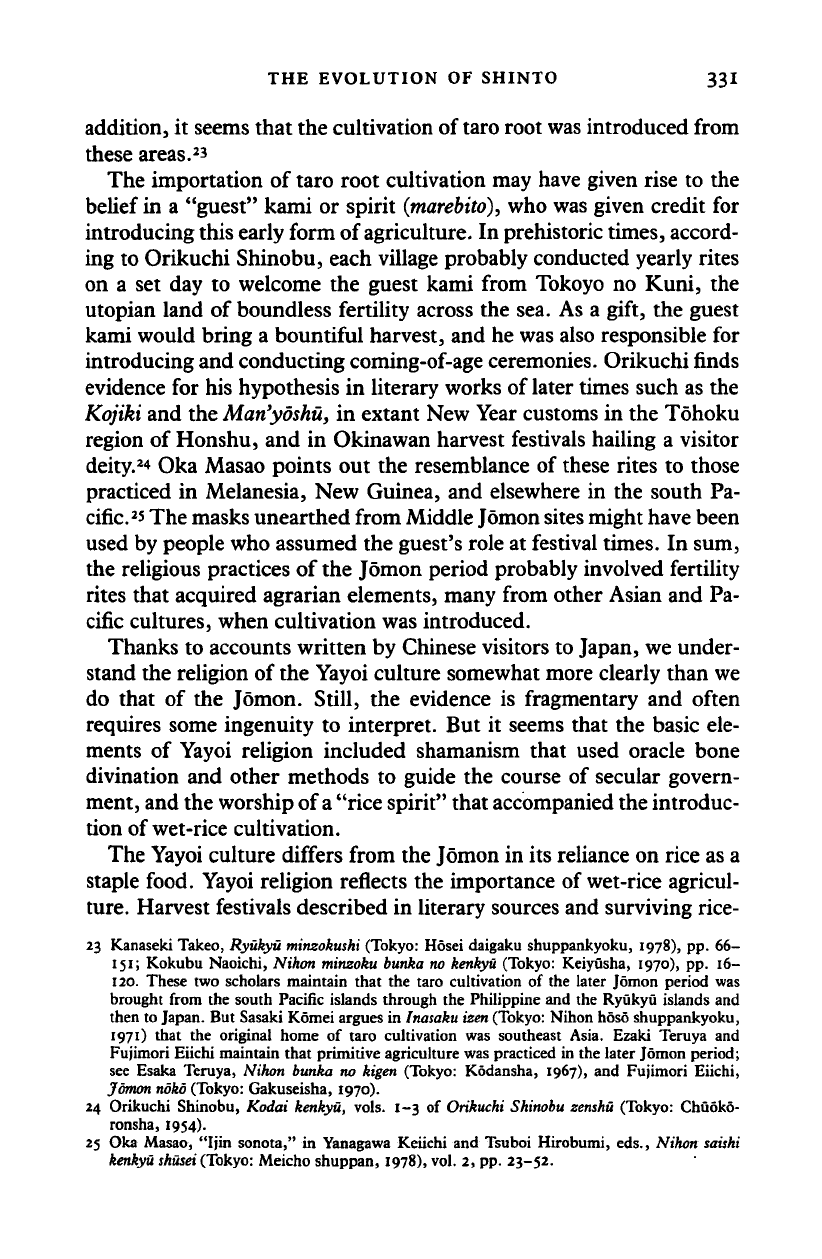
THE EVOLUTION OF SHINTO 331
addition, it seems that the cultivation of
taro
root was introduced from
these areas.
23
The importation of taro root cultivation may have given rise to the
belief in a "guest" kami or spirit
(marebito),
who was given credit for
introducing this early form of agriculture. In prehistoric times, accord-
ing to Orikuchi Shinobu, each village probably conducted yearly rites
on a set day to welcome the guest kami from Tokoyo no Kuni, the
Utopian land of boundless fertility across the sea. As a gift, the guest
kami would bring a bountiful harvest, and he was also responsible for
introducing and conducting coming-of-age ceremonies. Orikuchi finds
evidence for his hypothesis in literary works of later times such as the
Kojiki and the
Man'yoshu,
in extant New Year customs in the Tohoku
region of Honshu, and in Okinawan harvest festivals hailing a visitor
deity.
24
Oka Masao points out the resemblance of these rites to those
practiced in Melanesia, New Guinea, and elsewhere in the south Pa-
cific.
2
5
The masks unearthed from Middle Jomon
sites
might have been
used by people who assumed the guest's role at festival times. In sum,
the religious practices of the Jomon period probably involved fertility
rites that acquired agrarian elements, many from other Asian and Pa-
cific cultures, when cultivation was introduced.
Thanks to accounts written by Chinese visitors to Japan, we under-
stand the religion of the Yayoi culture somewhat more clearly than we
do that of the Jomon. Still, the evidence is fragmentary and often
requires some ingenuity to interpret. But it seems that the basic ele-
ments of Yayoi religion included shamanism that used oracle bone
divination and other methods to guide the course of secular govern-
ment, and the worship of
a
"rice spirit" that accompanied the introduc-
tion of wet-rice cultivation.
The Yayoi culture differs from the Jomon in its reliance on rice as a
staple food. Yayoi religion reflects the importance of wet-rice agricul-
ture.
Harvest festivals described in literary sources and surviving rice-
23 Kanaseki Takeo, Ryukyu minzokushi (Tokyo: Hosei daigaku shuppankyoku, 1978), pp. 66-
151;
Kokubu Naoichi, Nihon minzoku bunka no kenkyu (Tokyo: KeiyQsha, 1970), pp. 16-
120.
These two scholars maintain that the taro cultivation of the later Jomon period was
brought from the south Pacific islands through the Philippine and the Ryukyu islands and
then to Japan. But Sasaki Komei argues in Inasaku izen (Tokyo: Nihon hoso shuppankyoku,
1971) that the original home of taro cultivation was southeast Asia. Ezaki Teruya and
Fujimori Eiichi maintain that primitive agriculture was practiced in the later Jomon period;
see Esaka Teruya, Nihon bunka no kigen (Tokyo: Kodansha, 1967), and Fujimori Eiichi,
Jomon
nokd
(Tokyo: Gakuseisha, 1970).
24 Orikuchi Shinobu, Kodai kenkyu, vols. 1-3 of Orikuchi Shinobu zenshu (Tokyo: Chuoko-
ronsha, 1954).
25 Oka Masao, "Ijin sonota," in Yanagawa Keiichi and Tsuboi Hirobumi, eds., Nihon saishi
kenkyu shusei
(Tokyo: Meicho shuppan, 1978), vol. 2, pp. 23-52.
Cambridge Histories Online © Cambridge University Press, 2008
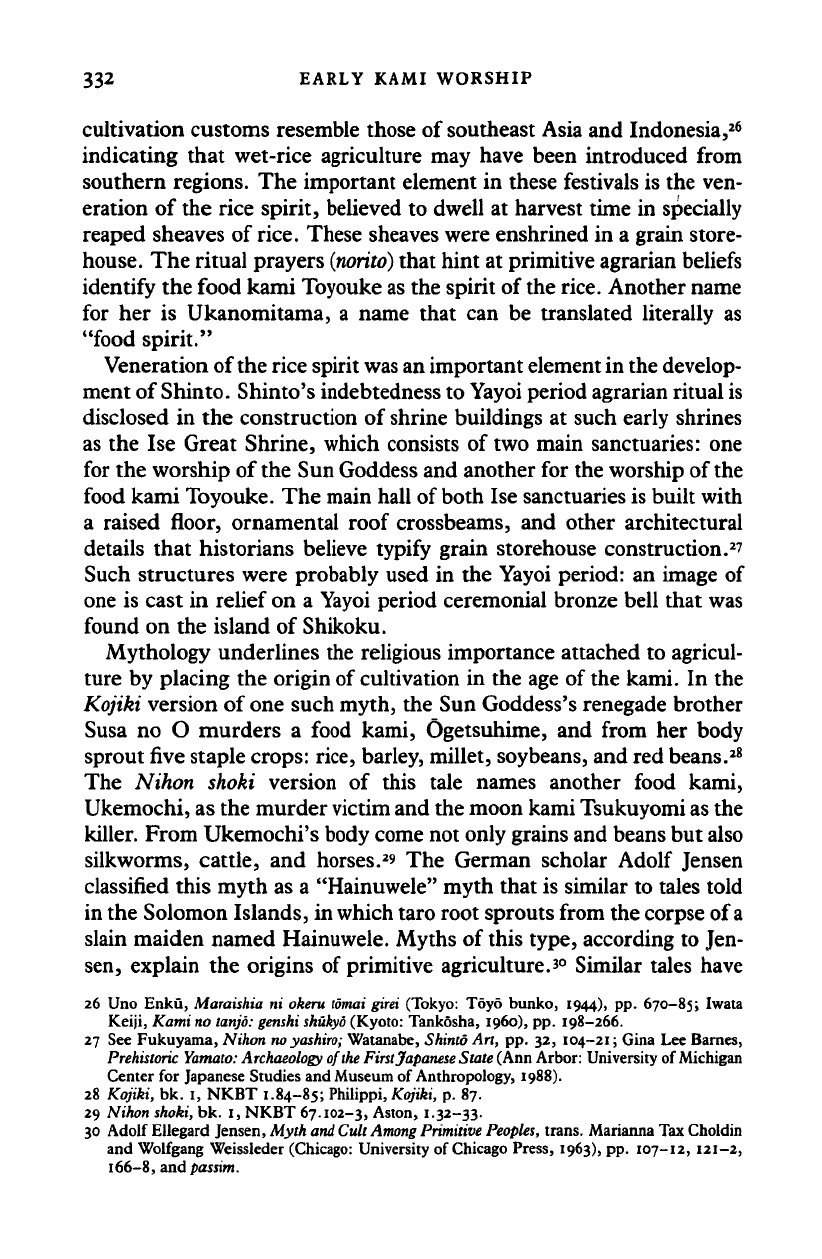
332 EARLY KAMI WORSHIP
cultivation customs resemble those of southeast Asia and Indonesia,
26
indicating that wet-rice agriculture may have been introduced from
southern regions. The important element in these festivals is the ven-
eration of the rice spirit, believed to dwell at harvest time in specially
reaped sheaves of
rice.
These sheaves were enshrined in a grain store-
house. The ritual prayers
(norito)
that hint at primitive agrarian beliefs
identify the food kami Toyouke as the spirit of the rice. Another name
for her is Ukanomitama, a name that can be translated literally as
"food spirit."
Veneration of the rice spirit
was
an important element in the develop-
ment of
Shinto.
Shinto's indebtedness to Yayoi period agrarian ritual is
disclosed in the construction of shrine buildings at such early shrines
as the Ise Great Shrine, which consists of two main sanctuaries: one
for the worship of the Sun Goddess and another for the worship of the
food kami Toyouke. The main hall of both Ise sanctuaries is built with
a raised floor, ornamental roof crossbeams, and other architectural
details that historians believe typify grain storehouse construction.
2
?
Such structures were probably used in the Yayoi period: an image of
one is cast in relief on a Yayoi period ceremonial bronze bell that was
found on the island of Shikoku.
Mythology underlines the religious importance attached to agricul-
ture by placing the origin of cultivation in the age of the kami. In the
Kojiki version of one such myth, the Sun Goddess's renegade brother
Susa no O murders a food kami, Ogetsuhime, and from her body
sprout five staple crops: rice, barley, millet, soybeans, and red beans.
28
The Nihon shoki version of this tale names another food kami,
Ukemochi, as the murder victim and the moon kami Tsukuyomi
as
the
killer. From Ukemochi's body come not only grains and beans but also
silkworms, cattle, and horses.
29
The German scholar Adolf Jensen
classified this myth as a "Hainuwele" myth that is similar to tales told
in the Solomon Islands, in which taro root sprouts from the corpse of a
slain maiden named Hainuwele. Myths of this type, according to Jen-
sen, explain the origins of primitive agriculture.3° Similar tales have
26 Uno Enku, Maraishia ni okeru
tomai
girei (Tokyo: Toyo bunko, 1944), pp. 670-85; Iwata
Keiji, Kami no lanjo: genshi
shukyo
(Kyoto: Tankosha, i960), pp. 198-266.
27 See Fukuyama, Nihon
no
yashiro;
Watanabe, Shinto An, pp. 32, 104-21; Gina Lee Barnes,
Prehistoric
Yamato:
Archaeology
of
the
First
Japanese
State (Ann Arbor: University of Michigan
Center for Japanese Studies and Museum of Anthropology, 1988).
28 Kojiki, bk. 1, NKBT 1.84-85; Philippi, Kojiki, p. 87.
29 Nihon shoki, bk. I, NKBT 67.102-3, Aston, 1.32-33.
30 Adolf EUegard Jensen, Myth and Cult
Among
Primitive Peoples, trans. Marianna Tax Choldin
and Wolfgang Weissleder (Chicago: University of Chicago Press, 1963), pp. 107-12, 121-2,
166-8,
and passim.
Cambridge Histories Online © Cambridge University Press, 2008
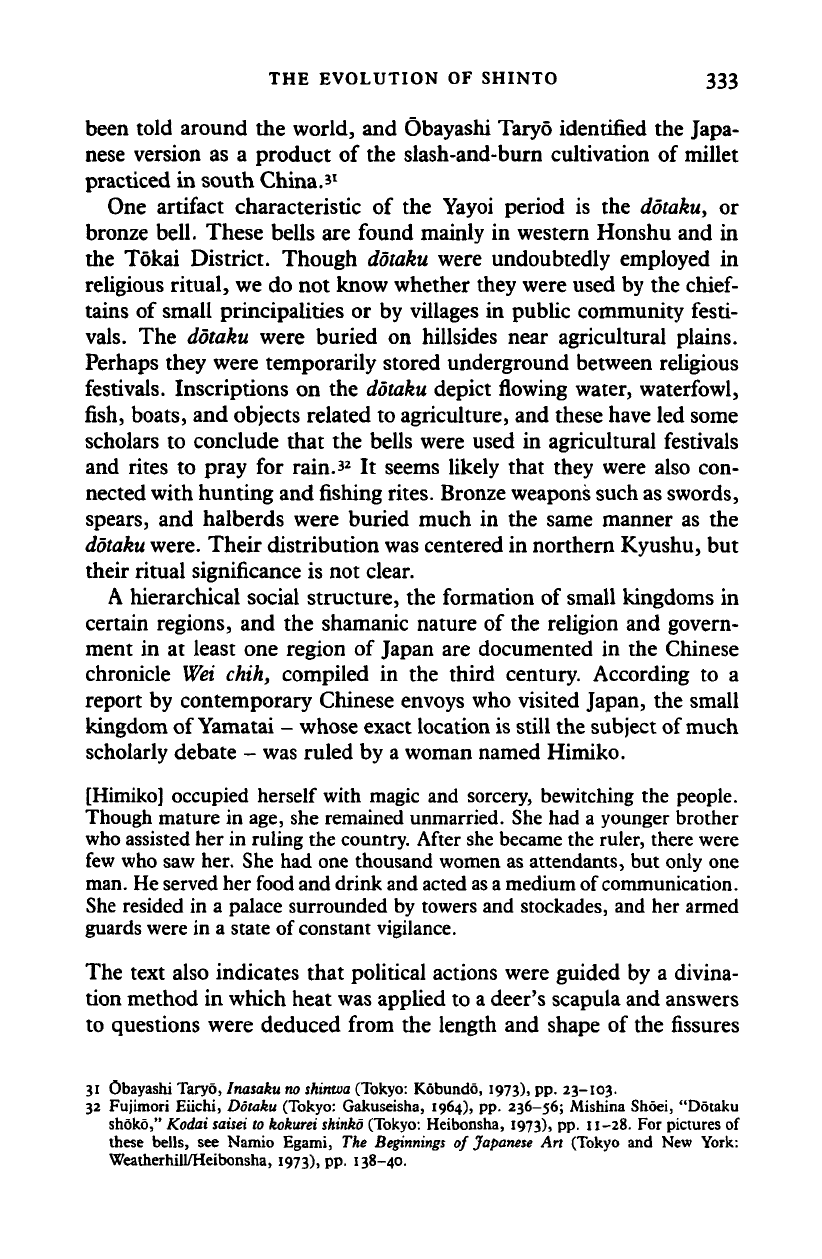
THE EVOLUTION OF SHINTO 333
been told around the world, and Obayashi Taryo identified the Japa-
nese version as a product of the slash-and-burn cultivation of millet
practiced in south China.'
1
One artifact characteristic of the Yayoi period is the dotaku, or
bronze bell. These bells are found mainly in western Honshu and in
the Tokai District. Though dotaku were undoubtedly employed in
religious ritual, we do not know whether they were used by the
chief-
tains of small principalities or by villages in public community festi-
vals.
The dotaku were buried on hillsides near agricultural plains.
Perhaps they were temporarily stored underground between religious
festivals. Inscriptions on the
dotaku
depict flowing water, waterfowl,
fish,
boats,
and objects related to agriculture, and these have led some
scholars to conclude that the bells were used in agricultural festivals
and rites to pray for rain.
32
It seems likely that they were also con-
nected with hunting and fishing rites. Bronze weapons such as swords,
spears, and halberds were buried much in the same manner as the
dotaku
were. Their distribution was centered in northern Kyushu, but
their ritual significance is not clear.
A hierarchical social structure, the formation of small kingdoms in
certain regions, and the shamanic nature of the religion and govern-
ment in at least one region of Japan are documented in the Chinese
chronicle Wei chih, compiled in the third century. According to a
report by contemporary Chinese envoys who visited Japan, the small
kingdom of Yamatai - whose exact location is still the subject of much
scholarly debate - was ruled by a woman named Himiko.
[Himiko] occupied herself with magic and sorcery, bewitching the people.
Though mature in age, she remained unmarried. She had a younger brother
who assisted her in ruling the country. After she became the ruler, there were
few who saw her. She had one thousand women as attendants, but only one
man. He served her food and drink and acted
as a
medium of communication.
She resided in a palace surrounded by towers and stockades, and her armed
guards were in a state of constant vigilance.
The text also indicates that political actions were guided by a divina-
tion method in which heat was applied to a deer's scapula and answers
to questions were deduced from the length and shape of the fissures
31 Obayashi Taryo, Inasaku
no
shinwa (Tokyo: Kobundo, 1973), pp. 23-103.
32 Fujimori Eiichi, Dotaku (Tokyo: Gakuseisha, 1964), pp. 236-56; Mishina Shod, "Dotaku
shdko," Kodai saisei to kokurei
shinko
(Tokyo: Heibonsha, 1973), pp. 11-28. For pictures of
these bells, see Namio Egami, The Beginnings of Japanese An (Tokyo and New York:
Weatherhill/Heibonsha, 1973), pp. 138-40.
Cambridge Histories Online © Cambridge University Press, 2008
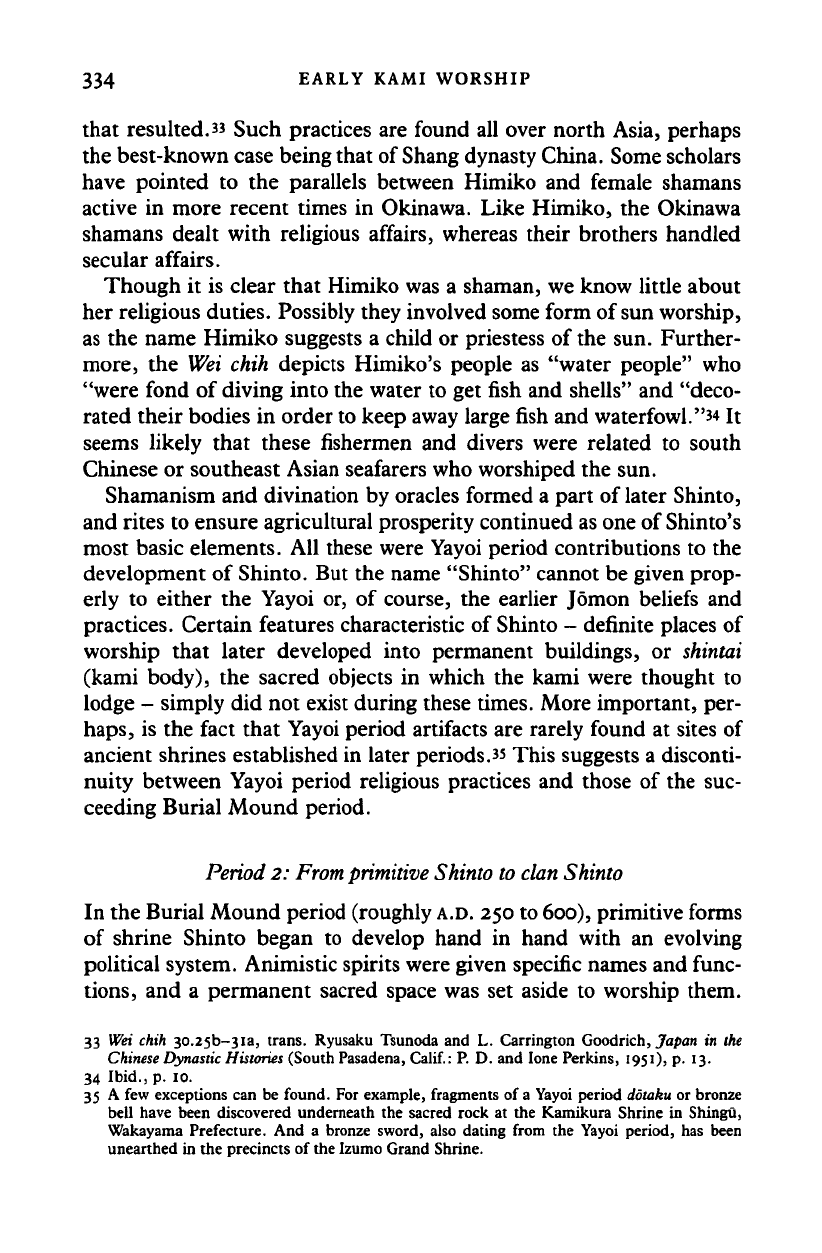
334 EARLY KAMI WORSHIP
that resulted.33 Such practices are found all over north Asia, perhaps
the best-known case being that of Shang dynasty China. Some scholars
have pointed to the parallels between Himiko and female shamans
active in more recent times in Okinawa. Like Himiko, the Okinawa
shamans dealt with religious affairs, whereas their brothers handled
secular affairs.
Though it is clear that Himiko was a shaman, we know little about
her religious duties. Possibly they involved some form of sun worship,
as the name Himiko suggests a child or priestess of the sun. Further-
more, the Wei chih depicts Himiko's people as "water people" who
"were fond of diving into the water to get fish and shells" and "deco-
rated their bodies in order to keep away large fish and waterfowl."34 it
seems likely that these fishermen and divers were related to south
Chinese or southeast Asian seafarers who worshiped the sun.
Shamanism and divination by oracles formed a part of later Shinto,
and rites to ensure agricultural prosperity continued as one of Shinto's
most basic elements. All these were Yayoi period contributions to the
development of Shinto. But the name "Shinto" cannot be given prop-
erly to either the Yayoi or, of course, the earlier Jomon beliefs and
practices. Certain features characteristic of Shinto - definite places of
worship that later developed into permanent buildings, or shintai
(kami body), the sacred objects in which the kami were thought to
lodge - simply did not exist during these times. More important, per-
haps,
is the fact that Yayoi period artifacts are rarely found at sites of
ancient shrines established in later periods.35 This suggests a disconti-
nuity between Yayoi period religious practices and those of the suc-
ceeding Burial Mound period.
Period 2: From primitive Shinto to clan Shinto
In the Burial Mound period (roughly
A.D.
250 to 600), primitive forms
of shrine Shinto began to develop hand in hand with an evolving
political system. Animistic spirits were given specific names and func-
tions,
and a permanent sacred space was set aside to worship them.
33 Wei chih 3O.25b-3ia, trans. Ryusaku Tsunoda and L. Carrington Goodrich, Japan in the
Chinese Dyiiastic Histories (South Pasadena,
Calif.:
P. D. and lone Perkins, 1951), p. 13.
34 Ibid., p. 10.
35 A few exceptions can be found. For example, fragments of a Yayoi period doiaku or bronze
bell have been discovered underneath the sacred rock at the Kamikura Shrine in Shingu,
Wakayama Prefecture. And a bronze sword, also dating from the Yayoi period, has been
unearthed in the precincts of the Izumo Grand Shrine.
Cambridge Histories Online © Cambridge University Press, 2008
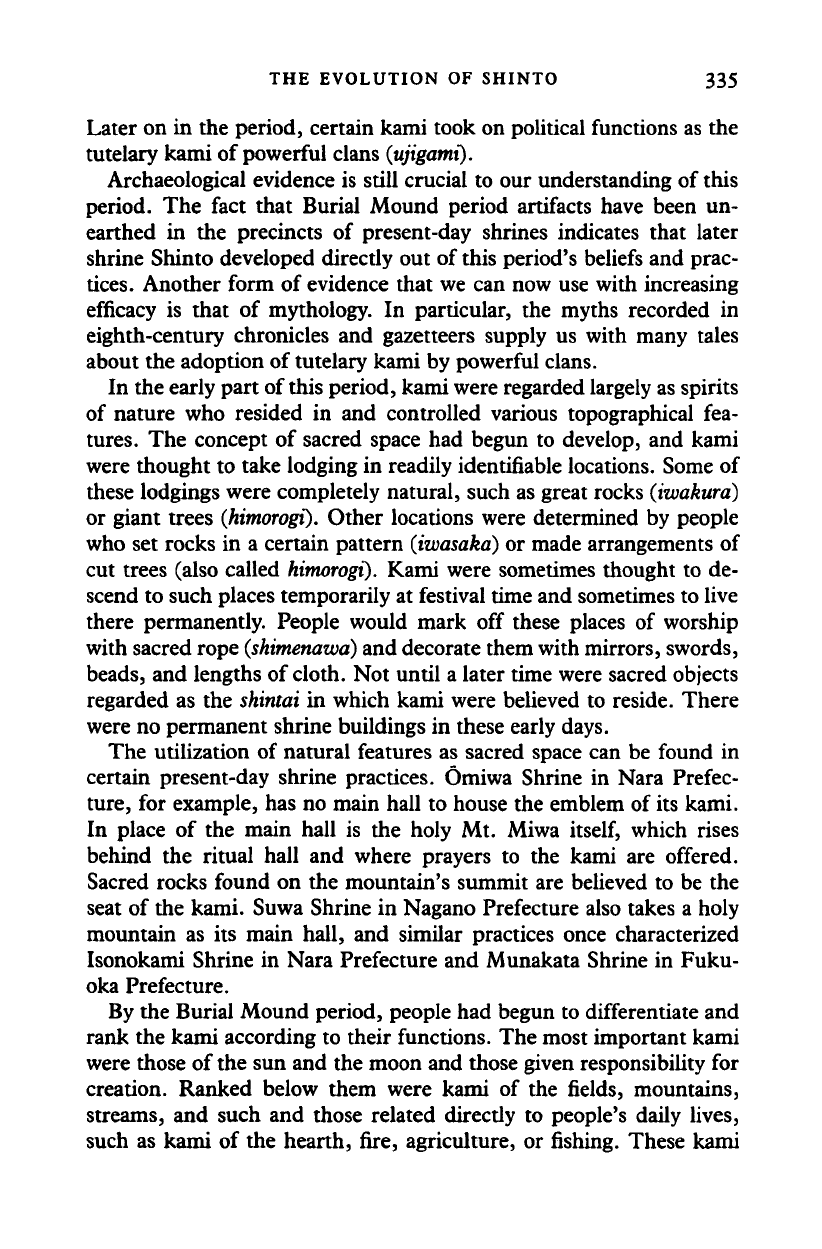
THE EVOLUTION OF SHINTO 335
Later on in the period, certain kami took on political functions as the
tutelary kami of powerful clans
(ujigami).
Archaeological evidence is still crucial to our understanding of this
period. The fact that Burial Mound period artifacts have been un-
earthed in the precincts of present-day shrines indicates that later
shrine Shinto developed directly out of this period's beliefs and prac-
tices.
Another form of evidence that we can now use with increasing
efficacy is that of mythology. In particular, the myths recorded in
eighth-century chronicles and gazetteers supply us with many tales
about the adoption of tutelary kami by powerful clans.
In the early part of
this
period, kami were regarded largely as spirits
of nature who resided in and controlled various topographical fea-
tures.
The concept of sacred space had begun to develop, and kami
were thought to take lodging in readily identifiable locations. Some of
these lodgings were completely natural, such as great rocks
(iwakura)
or giant trees
(himorogi).
Other locations were determined by people
who set rocks in a certain pattern
(iwasaka)
or made arrangements of
cut trees (also called
himorogi).
Kami were sometimes thought to de-
scend to such places temporarily at festival time and sometimes to live
there permanently. People would mark off these places of worship
with sacred rope
(shimenawa)
and decorate them with mirrors, swords,
beads,
and lengths of
cloth.
Not until a later time were sacred objects
regarded as the
shintai
in which kami were believed to reside. There
were no permanent shrine buildings in these early days.
The utilization of natural features as sacred space can be found in
certain present-day shrine practices. Omiwa Shrine in Nara Prefec-
ture,
for example, has no main hall to house the emblem of its kami.
In place of the main hall is the holy Mt. Miwa
itself,
which rises
behind the ritual hall and where prayers to the kami are offered.
Sacred rocks found on the mountain's summit are believed to be the
seat of the kami. Suwa Shrine in Nagano Prefecture also takes a holy
mountain as its main hall, and similar practices once characterized
Isonokami Shrine in Nara Prefecture and Munakata Shrine in Fuku-
oka Prefecture.
By the Burial Mound period, people had begun to differentiate and
rank the kami according to their functions. The most important kami
were those of the sun and the moon and those given responsibility for
creation. Ranked below them were kami of the fields, mountains,
streams, and such and those related directly to people's daily lives,
such as kami of the hearth, fire, agriculture, or fishing. These kami
Cambridge Histories Online © Cambridge University Press, 2008
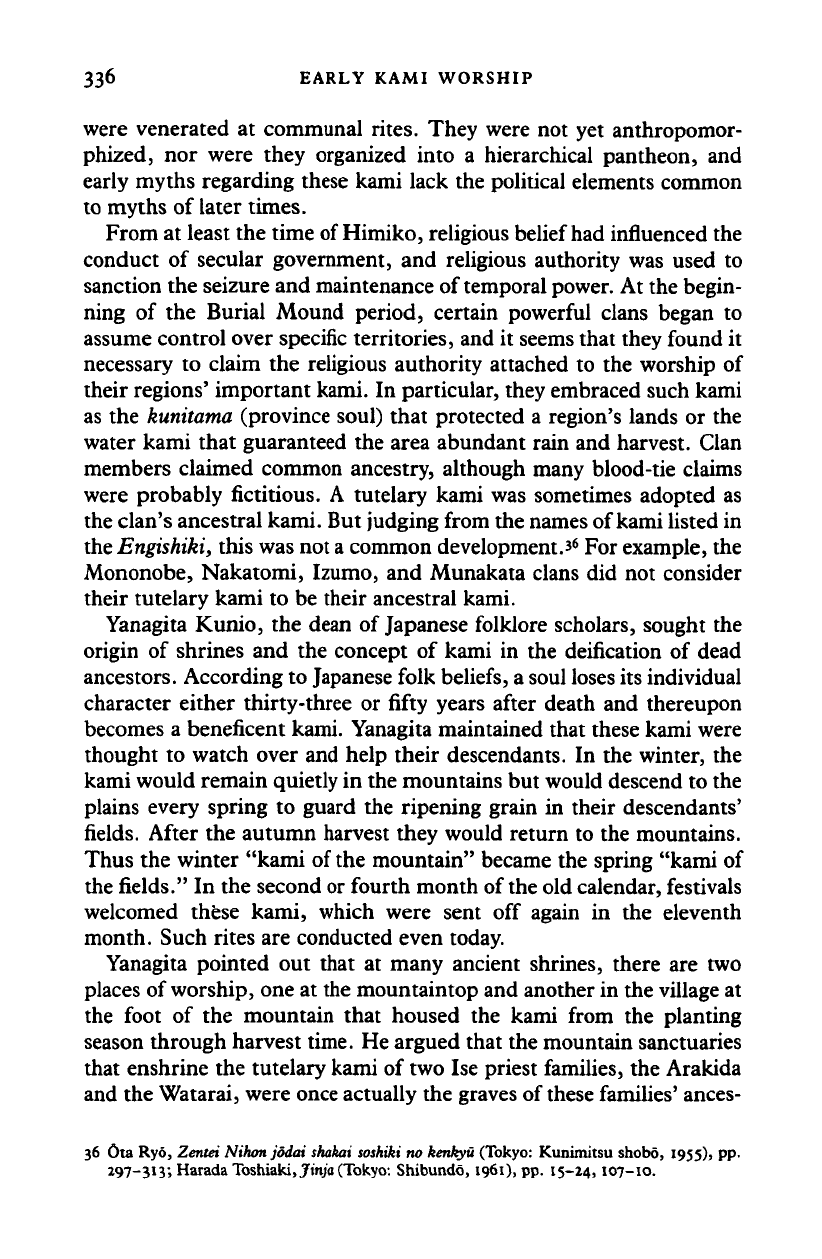
336 EARLY KAMI WORSHIP
were venerated at communal rites. They were not yet anthropomor-
phized, nor were they organized into a hierarchical pantheon, and
early myths regarding these kami lack the political elements common
to myths of later times.
From at least the time of
Himiko,
religious belief had influenced the
conduct of secular government, and religious authority was used to
sanction the seizure and maintenance of temporal power. At the begin-
ning of the Burial Mound period, certain powerful clans began to
assume control over specific territories, and it seems that they found it
necessary to claim the religious authority attached to the worship of
their regions' important kami. In particular, they embraced such kami
as the kunitama (province soul) that protected a region's lands or the
water kami that guaranteed the area abundant rain and harvest. Clan
members claimed common ancestry, although many blood-tie claims
were probably fictitious. A tutelary kami was sometimes adopted as
the clan's ancestral kami. But judging from the names of kami listed in
the
Engishiki,
this was not
a
common development.*
6
For example, the
Mononobe, Nakatomi, Izumo, and Munakata clans did not consider
their tutelary kami to be their ancestral kami.
Yanagita Kunio, the dean of Japanese folklore scholars, sought the
origin of shrines and the concept of kami in the deification of dead
ancestors. According to Japanese folk beliefs, a soul loses its individual
character either thirty-three or fifty years after death and thereupon
becomes a beneficent kami. Yanagita maintained that these kami were
thought to watch over and help their descendants. In the winter, the
kami would remain quietly in the mountains but would descend to the
plains every spring to guard the ripening grain in their descendants'
fields. After the autumn harvest they would return to the mountains.
Thus the winter "kami of the mountain" became the spring "kami of
the fields." In the second or fourth month of
the
old calendar, festivals
welcomed these kami, which were sent off again in the eleventh
month. Such rites are conducted even today.
Yanagita pointed out that at many ancient shrines, there are two
places of
worship,
one at the mountaintop and another in the village at
the foot of the mountain that housed the kami from the planting
season through harvest time. He argued that the mountain sanctuaries
that enshrine the tutelary kami of two Ise priest families, the Arakida
and the Watarai, were once actually the graves of these families' ances-
36 Ota Ryo, Zentei Nikon jodai shakai soshiki no kenkyu (Tokyo: Kunimitsu shobo, 1955), pp.
297-313;
HaradaToshiaki, Jin/a (Tokyo: Shibundo, 1961), pp. 15-24, 107-10.
Cambridge Histories Online © Cambridge University Press, 2008
